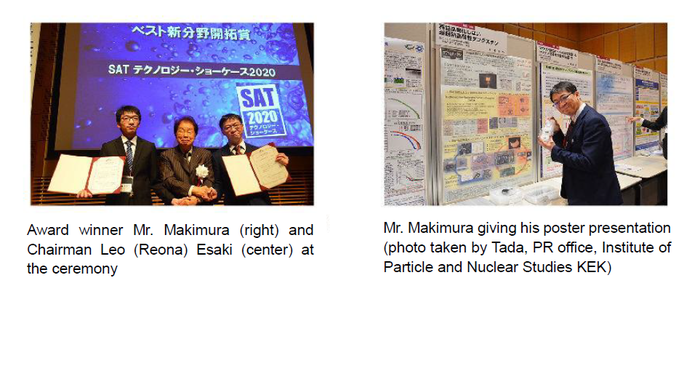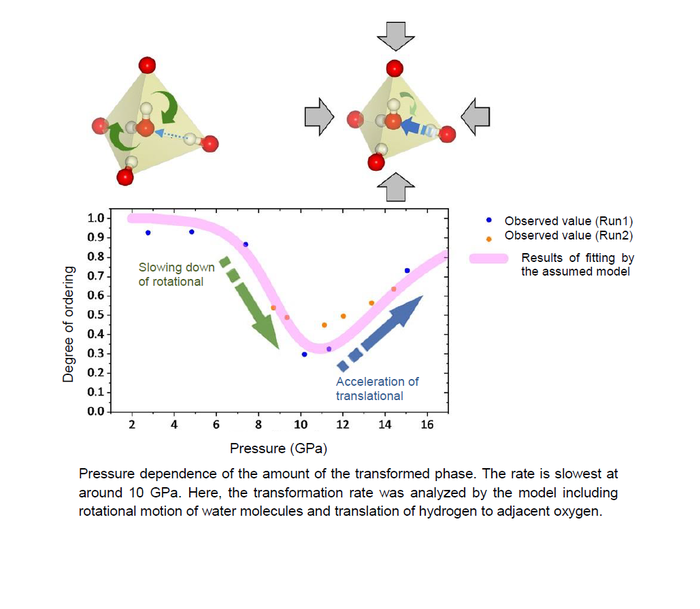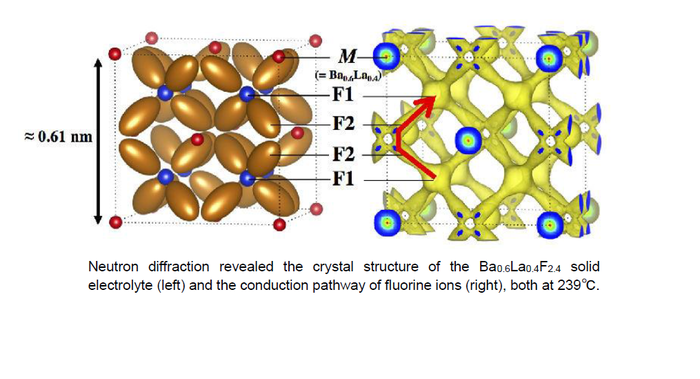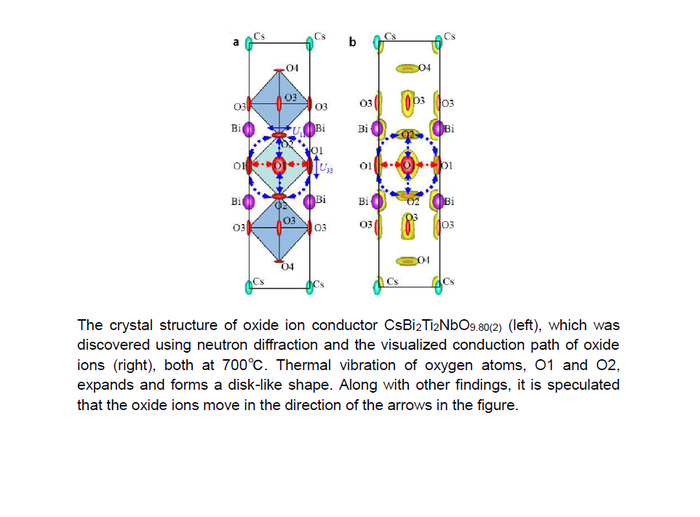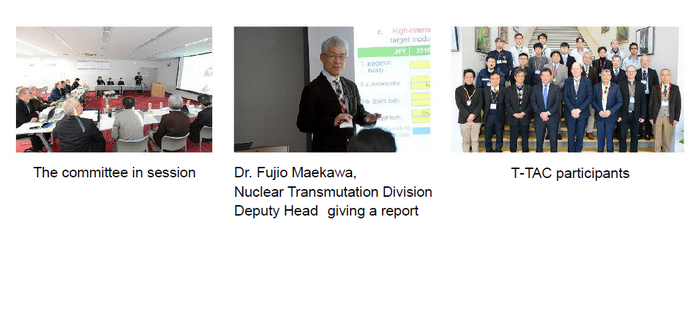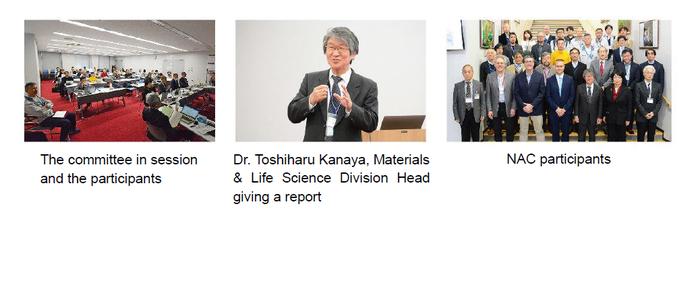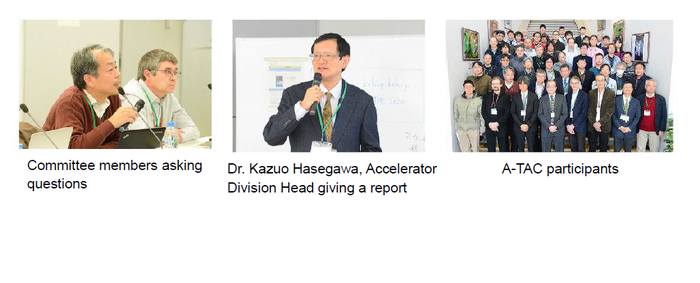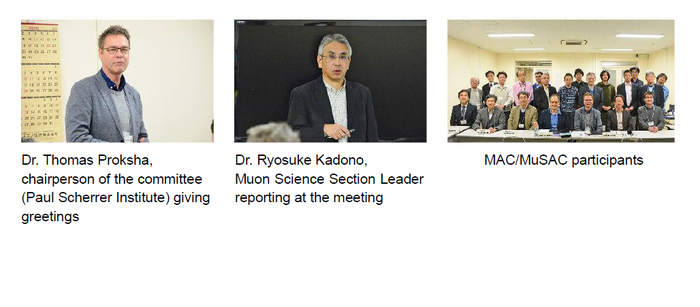J-PARC NEWS March 2020 (Issue #179)
■Mr. Shunsuke Makimura Won the "Best Presentation Award for Opening New Frontier" at SCIENCE ACADEMY OF TSUKUBA (SAT) Technology Showcase 2020 (January 24, Tsukuba International Congress Center)
Mr. Shunsuke Makimura (KEK engineer) is a member of the COMET experiment * in Hadron section of J-PARC center. He received the "Best Presentation Award for Opening New Frontier" at the SAT Technology Showcase 2020 organized by the Science Academy of Tsukuba. This award is given to a research theme that is recognized as the greatest advancement of a new field through selection from many poster presentations in various fields. Mr. Makimura gave a presentation on the research and development of "Toughened Fine-Grained Recrystallized tungsten alloy", which is used for target material to produce muons. The recrystallization embrittlement of tungsten takes place in high temperature by protons-irradiation and causes failure of the target. The tungsten alloy is developed to solve the challenging problem: recrystallization embrittlement.
* The COMET (COherent Muon to Electron Transition) experiment is an international joint experiment, with the goal of discovering new laws of physics using muons at the Hadron Experimental Facility.
■Mystery of Ice Revealed by Neutron Diffraction Experiments -Changes in hydrogen migration patterns caused various abnormalities under high pressure- (March 10, Press Release)
Ice is known to have various crystal structures with different arrangements of water molecules, depending on temperature and pressure. Among these structures, "Ice VII", which is stable over a wide pressure range of 2 GPa or more, is reported to exhibit anomalous behavior near 10 GPa. The anomaly was suggested to be related to hydrogen motion in the crystal structure, but the details have not been well understood. Neutron diffraction experiments are very useful for investigating such behavior. Dr. Komatsu, associate professor at the University of Tokyo, and his collaborators have investigated the kinetics of the transformation from ice VII to ice VIII which is accompanied by hydrogen movement at high-pressure neutron PLANET beamline, and found that the transformation rate becomes the slowest near 10 GPa. By analyzing the rate with the model in which the transformation occurs by translational and rotational diffusion of water molecules, they found that the previously reported anomaly is explainable by slowing down of rotational motion and acceleration of the translational one with pressure and resulting cross over around 10 GPa. The same phenomena may be observed in other substances with hydrogen bonds; thus, this finding is expected to promote further researches of hydrogen bonded materials.
■Elucidation of Ion Conduction Mechanism of Fluoride Ion Conductive Solid Electrolyte -The challenge of creating innovative storage batteries that surpass the performance of lithium-ion batteries- (March 12, Press Release)
Fluoride shuttle batteries are one of the leading candidates for innovative storage batteries (post-lithium-ion), which are expected to make a significant contribution to solving current energy issues. The key to this innovation is the development of an electrolyte material that allows fluoride ions, which are the carriers of electricity, to move quickly. Barium fluoride (BaF2) has an advantage of being able to withstand high voltage, which is important for battery performance, while it is a substance that does not readily allow flow of fluoride ions (low fluoride ion conductivity). Yet it has been acknowledged that with partial replacement of barium (Ba) with lanthanum (La), the fluoride ion conductivity dramatically improves. Associate Professor Mori of Kyoto University, Associate Professor Mineshige of the University of Hyogo, and Project Associate Professor Saito of the Institute for Materials Structure Science, High Energy Accelerator Research Organization (KEK), accurately determined the crystal structure of the Ba0.6La0.4F2.4 solid electrolyte by using SPICA (Special Environment Neutron Powder Diffractometer) for storage battery research at J-PARC. Neutron diffraction is useful for locating light elements such as fluorine. Also, the researchers succeeded in visualizing fluorine ion conduction pathways using data analysis software Z-Code (developed by KEK). As a result, it was discovered that a mechanism based on "interstitialcy diffusion," in which fluoride ions present at interstitial sites (non-regular locations of atoms, see Figure F2) push out fluoride ions at regular locations (F1), allows the fluorine ions to flow in the conduction pathway. This result is expected to make a major contribution to the development of electrolyte materials for fluoride shuttle batteries.
■Discovered New Best in the World Electrolyte Material -Accelerated development of fuel cells, sensors, and electronic materials- (March 13, Press Release)
Oxide ion conductors are widely applicable materials used for solid oxide fuel cells, oxygen separation membranes, catalysts, gas sensors, and more. Professor Yashima and others at Tokyo Institute of Technology discovered the first oxide ion conductor CsBi2Ti2NbO10–δ among these materials with a layered crystal structure called the Dion-Jacobson phase. Furthermore, from the crystal structure analysis using J-PARC’s neutron diffractometer, SuperHRPD, they discovered that at high temperature, where the oxide ion conductivity became high, the crystal structure changed and the oxygen deficiency in the crystal increased. Furthermore, with data analysis software Z-Code (developed by KEK), they were able to visualize the conduction path of oxide ions. This revealed the mechanism of how this new oxide ionic conductor achieved high ionic conductivity. This result will promote research on Dion-Jacobson type oxide ion conductors. Also, it offered a good prospect to be applied to material development, which will contribute to solving energy and environmental problems.
■Held J-PARC Advisory Committee (February 6-26)
From February 6 to 26, the J-PARC Center held advisory committee meetings in 4 areas: “Transmutation Experimental Facility Technology (T-TAC), Neutron Experimental Facility (NAC), Accelerator Technology (A-TAC), and Muon Experimental Facility (MAC)”. Experts from all over the world gathered and gave advice and recommendations regarding the status of J-PARC’s accelerators and experimental facilities, research progress, and plans for the future.
At the beginning of each meeting, J-PARC Director Naohito Saito explained the current status of J-PARC and requested for deliberations for the committee. Then, the responsible personnel of the facilities and the system operators explained the current status and plans for the future of each facility. In return, they received advice. Below are the details of each meeting.
-The 6th T-TAC (February 6-7)-
The J-PARC Center reported on the status of elemental technology development regarding the lead-bismuth target and proton beam technology, and future R&D plans. In return, the committee stated that the direction of the technology development and the future R&D plans were appropriate in general. During this meeting, committee members visited facilities for the elemental technology development such as liquid lead-bismuth test loops.
-NAC2020 (February 17-18)-
The J-PARC Center reported on the current status, business model, research results, and plans for the future of the Materials and Life Science Facility (MLF). The parallel sessions on the latest research findings and reports on neutron sources enabled the participants to efficiently exchange opinions. The committee's comments and suggestions included: the expansion plan to achieve 1 MW operation was appropriate, the new target design should reflect the inspection results of the used containers, and the knowledge of related facilities overseas should be referred to regarding the handling of radioactive gas waste.
-A-TAC 2020 (February 24-26)-
Three out of nine members of the committee joined the meeting via a videoconference. The discussion included the status of the accelerator, the result of new technology development, the enhancement plan, and responses to the previous suggestions. The accelerator was highly evaluated for its continuous operation at 500 kW at the MLF, its increased capacity to 510 kW for neutrino experiments, and the high operation rate for both purposes. The committee suggested that to continue its stable operation, it would be necessary to secure human resources and improve the efficiency of beam adjustment and operation. Furthermore, they added that an effort to increase operation time, stocking up enough backup supplies to maintain the high rate of operation, and the sophistication of the equipment protection system should be included as items for continuous consideration.
-The 7th MAC / The 14th MuSAC (February 25-26)-
At the MAC, which also serves as the KEK Muon Scientific Advisory Committee (MuSAC is held every 3 years), the current status of the muon experimental facility (including muon production targets and each beamline), research results, and future Muon Science Establishment (MUSE) plans were reported. In return, the committee highly evaluated the operation status of the MLF and the research results of MUSE. It also expressed expectations for stable operation at 1 MW for the future and suggested the needs for enforced project management through user support, construction, and development. During the meeting, the participants visited to the MUSE facility.

